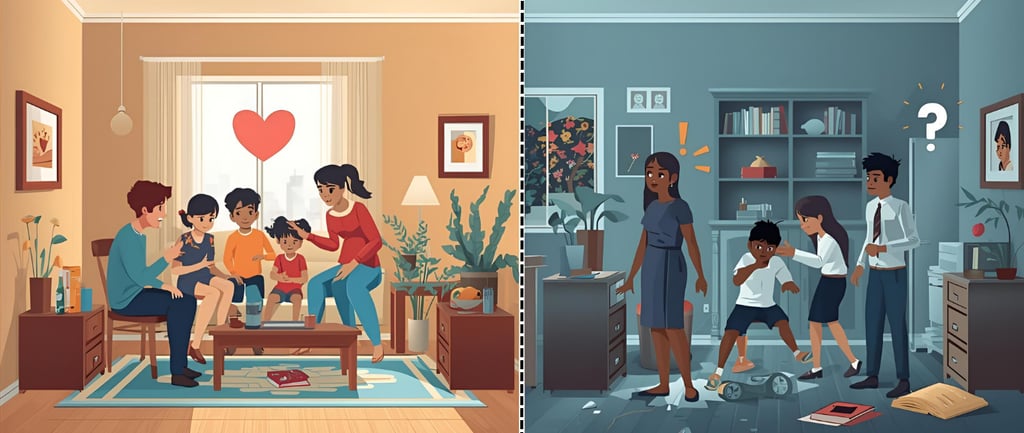Healing Begins At Home
Spurthi M.G. | Consultant Psychologist | Friend Indeed
11/19/20253 min read


Have you ever wondered why some children grow up grounded and self-assured, while others struggle with heavy emotions, anxiety, or self-doubt even when they’re raised under the same roof?
Most of us look at factors that we can easily reason out; like the child’s behavior, their reactions, their mood on a particular day. But underneath all of that, is something far quieter that we often overlook… the emotional rhythm of the home they grow up in.
Those daily patterns, the spoken and unspoken ones, are what psychologists call Family Dynamics. In many ways, they’re like the weather system of a household. Some days warm. Some days cloudy. Some days stormy.
These patterns include the way family members talk to each other, how emotions are handled within the family, who makes the decisions, how conflict unfolds, and the subtle “rules” that everyone seems to follow without anyone ever explaining them. Adults may not think twice about these habits, but for a child, they become the blueprint for everything; the relationships they form later on, communication patterns, coping skills, and even the tone of their inner voice.
Think back to your own childhood for a moment.
How were feelings talked about in your home?
What happened when someone was upset?
Did you talk, avoid, pretend nothing happened, or end up in a fight?
Did you feel safe asking questions? Could you raise an objection? Could you express when something hurt?
Most of us don’t realize how much those emotional climates still echo inside us. And today’s children are shaped by the same forces.
When a home feels warm, predictable, and responsive, kids carry that sense of safety with them. They learn that emotions aren’t dangerous, that people can be trusted, and that mistakes are part of learning and not proof that something is wrong with them. These kids often grow into adults with steadier emotional regulation, healthier relationships, and a more grounded sense of who they are.
But when the emotional climate is tense, distant, or unpredictable, children absorb that too.
Not through logic but through feelings and emotions.
And when kids don’t understand why something feels off, they turn the story inward:
Maybe it’s my fault.
Maybe I shouldn’t ask for anything.
Maybe I should stay quiet so I don’t make things worse.
Maybe my feelings are too much.
Those beliefs can stay with them long after childhood ends.
And it’s not always the big moments like yelling or arguments that shape a child. It’s often the quiet things like a parent who’s physically present but emotionally far away, a home where hard topics go untouched, a family that values calm so much that emotions get tucked out of sight.
Children learn from what is said, but they learn just as much from what is left unsaid. They watch how adults communicate.
Do they talk things through?
Shut down?
Blame?
Ignore?
Research has proven that children rehearse these patterns in their friendships, later in their romantic relationships, and even in the private conversations they have with themselves.
None of this is about blame. Families are made of humans, and humans bring stress, memories, fears, and old habits into the home. Most parents do the best they can with what they’ve learned. Many never had models for emotional communication in the first place.
This is where an Emotional Fitness Lounge like Friend Indeed plays a pivotal role in helping parents/caregivers deeply comprehend themselves and recognize patterns, followed by facilitating with practical tools to communicate with clarity, and build connection without judgment or pressure. Just as it is with children, with the right support to the elders of the family, small shifts can bring more calm and closeness into a home.
Understanding family dynamics gives us something powerful.
A choice.
A choice to notice the patterns we inherited and to gently reshape them.
A choice to build homes where emotions are welcome, where healing comes subsequent to hurt, where boundaries feel safe, and where connection matters more than control.
For parents, change often starts with simple awareness:
“When I’m overwhelmed, I shut down.”
“I raise my voice when I’m scared, not angry.”
Awareness is not judgment. It’s the doorway to something healthier. Often uncomfortable, sometimes even scary; but definitely healthier.
Yes, Family Dynamics shape children deeply; affirmatively or negatively.
However, the promising truth?
They can be reshaped at any time.
Write to us at support@friendindeed.in
© 2025 Friend Indeed. All rights reserved.
DISCLAIMER:
This platform does not provide psychotherapy, medical advice, or suicide prevention services. For mental health emergencies or suicidal ideation, please seek assistance from a qualified medical professional.
Your friend indeed is just one click away
